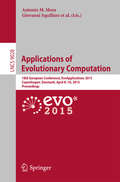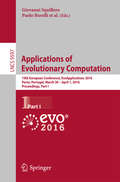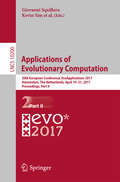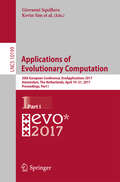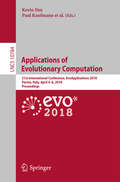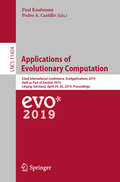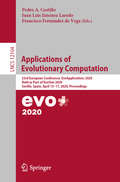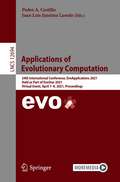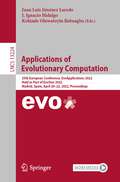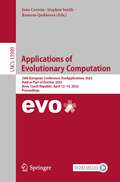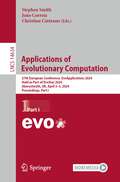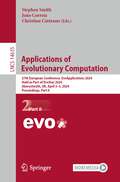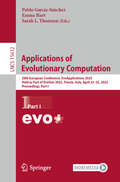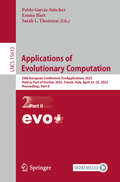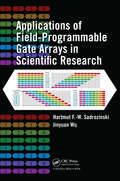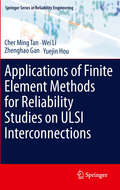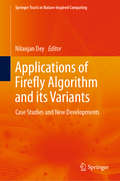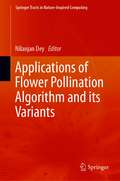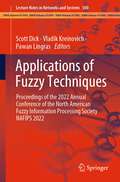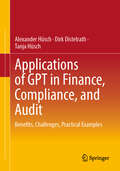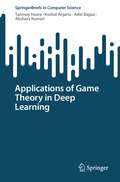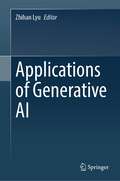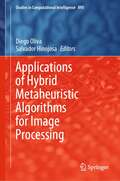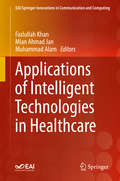- Table View
- List View
Applications of Evolutionary Computation: 18th European Conference, EvoApplications 2015, Copenhagen, Denmark, April 8-10, 2015, Proceedings (Lecture Notes in Computer Science #9028)
by Giovanni Squillero Antonio M. MoraThis book constitutes the refereed conference proceedings of the 18th International Conference on the Applications of Evolutionary Computation, EvoApplications 2015, held in Copenhagen, Spain, in April 2015, colocated with the Evo 2015 events EuroGP, EvoCOP, and EvoMUSART. The 72 revised full papers presented were carefully reviewed and selected from 125 submissions. EvoApplications 2015 consisted of the following 13 tracks: EvoBIO (evolutionary computation, machine learning and data mining in computational biology), EvoCOMNET (nature-inspired techniques for telecommunication networks and other parallel and distributed systems), EvoCOMPLEX (evolutionary algorithms and complex systems), EvoENERGY (evolutionary computation in energy applications), EvoFIN (evolutionary and natural computation in finance and economics), EvoGAMES (bio-inspired algorithms in games), EvoIASP (evolutionary computation in image analysis, signal processing, and pattern recognition), EvoINDUSTRY (nature-inspired techniques in industrial settings), EvoNUM (bio-inspired algorithms for continuous parameter optimization), EvoPAR (parallel implementation of evolutionary algorithms), EvoRISK (computational intelligence for risk management, security and defence applications), EvoROBOT (evolutionary computation in robotics), and EvoSTOC (evolutionary algorithms in stochastic and dynamic environments).
Applications of Evolutionary Computation: 19th European Conference, EvoApplications 2016, Porto, Portugal, March 30 -- April 1, 2016, Proceedings, Part I (Lecture Notes in Computer Science #9597)
by Paolo Burelli Giovanni SquilleroThetwo volumes LNCS 9597 and 9598 constitute the refereed conference proceedingsof the 19th European Conference on the Applications of Evolutionary Computation,EvoApplications 2016, held in Porto, Portugal, in March/April 2016, co-locatedwith the Evo* 2016 events EuroGP, EvoCOP, and EvoMUSART. The57 revised full papers presented together with 17 poster papers were carefullyreviewed and selected from 115 submissions. EvoApplications 2016 consisted ofthe following 13 tracks: EvoBAFIN (natural computing methods in businessanalytics and finance), EvoBIO (evolutionary computation, machine learning anddata mining in computational biology), EvoCOMNET (nature-inspired techniquesfor telecommunication networks and other parallel and distributed systems),EvoCOMPLEX (evolutionary algorithms and complex systems), EvoENERGY(evolutionary computation in energy applications), EvoGAMES (bio-inspiredalgorithms in games), EvoIASP (evolutionary computation in image analysis,signal processing, and pattern recognition), EvoINDUSTRY (nature-inspiredtechniques in industrial settings), EvoNUM (bio-inspired algorithms forcontinuous parameter optimization), EvoPAR (parallel implementation ofevolutionary algorithms), EvoRISK (computational intelligence for riskmanagement, security and defence applications), EvoROBOT (evolutionaryrobotics), and EvoSTOC (evolutionary algorithms in stochastic and dynamicenvironments).
Applications of Evolutionary Computation: 19th European Conference, Evoapplications 2016, Porto, Portugal, March 30 -- April 1, 2016, Proceedings, Part I (Lecture Notes in Computer Science #9597)
by Kevin Sim Giovanni SquilleroThis book constitutes the refereed conference proceedings of the 18th International Conference on the Applications of Evolutionary Computation, EvoApplications 2015, held in Copenhagen, Spain, in April 2015, colocated with the Evo 2015 events EuroGP, EvoCOP, and EvoMUSART. The 72 revised full papers presented were carefully reviewed and selected from 125 submissions. EvoApplications 2015 consisted of the following 13 tracks: EvoBIO (evolutionary computation, machine learning and data mining in computational biology), EvoCOMNET (nature-inspired techniques for telecommunication networks and other parallel and distributed systems), EvoCOMPLEX (evolutionary algorithms and complex systems), EvoENERGY (evolutionary computation in energy applications), EvoFIN (evolutionary and natural computation in finance and economics), EvoGAMES (bio-inspired algorithms in games), EvoIASP (evolutionary computation in image analysis, signal processing, and pattern recognition), EvoINDUSTRY (nature-inspired techniques in industrial settings), EvoNUM (bio-inspired algorithms for continuous parameter optimization), EvoPAR (parallel implementation of evolutionary algorithms), EvoRISK (computational intelligence for risk management, security and defence applications), EvoROBOT (evolutionary computation in robotics), and EvoSTOC (evolutionary algorithms in stochastic and dynamic environments).
Applications of Evolutionary Computation: 19th European Conference, Evoapplications 2016, Porto, Portugal, March 30 -- April 1, 2016, Proceedings, Part I (Lecture Notes in Computer Science #9597)
by Kevin Sim Giovanni SquilleroThis book constitutes the refereed conference proceedings of the 18th International Conference on the Applications of Evolutionary Computation, EvoApplications 2015, held in Copenhagen, Spain, in April 2015, colocated with the Evo 2015 events EuroGP, EvoCOP, and EvoMUSART. The 72 revised full papers presented were carefully reviewed and selected from 125 submissions. EvoApplications 2015 consisted of the following 13 tracks: EvoBIO (evolutionary computation, machine learning and data mining in computational biology), EvoCOMNET (nature-inspired techniques for telecommunication networks and other parallel and distributed systems), EvoCOMPLEX (evolutionary algorithms and complex systems), EvoENERGY (evolutionary computation in energy applications), EvoFIN (evolutionary and natural computation in finance and economics), EvoGAMES (bio-inspired algorithms in games), EvoIASP (evolutionary computation in image analysis, signal processing, and pattern recognition), EvoINDUSTRY (nature-inspired techniques in industrial settings), EvoNUM (bio-inspired algorithms for continuous parameter optimization), EvoPAR (parallel implementation of evolutionary algorithms), EvoRISK (computational intelligence for risk management, security and defence applications), EvoROBOT (evolutionary computation in robotics), and EvoSTOC (evolutionary algorithms in stochastic and dynamic environments).
Applications of Evolutionary Computation: 21st European Conference, Evoapplications 2018, Parma, Italy, April 4-6, 2018, Proceedings (Lecture Notes in Computer Science #10784)
by Kevin Sim Paul KaufmannThis book constitutes the refereed conference proceedings of the 21st International Conference on the Applications of Evolutionary Computation, EvoApplications 2018, held in Parma, Italy, in April 2018, collocated with the Evo* 2018 events EuroGP, EvoCOP, and EvoMUSART. <P><P> The 59 revised full papers presented were carefully reviewed and selected from 84 submissions. EvoApplications 2018 combined research from 14 different domains: business analytics and finance (EvoBAFIN); computational biology (EvoBIO); communication networks and other parallel and distributed systems (EvoCOMNET); complex systems (EvoCOMPLEX); energy-related optimization (EvoENERGY); games and multi-agent systems (EvoGAMES); image analysis, signal processing and pattern recognition (EvoIASP); realworld industrial and commercial environments (EvoINDUSTRY); knowledge incorporation in evolutionary computation (EvoKNOW); continuous parameter optimization (EvoNUM); parallel architectures and distributed infrastructures (EvoPAR); evolutionary robotics (EvoROBOT); nature-inspired algorithms in software engineering and testing (EvoSET); and stochastic and dynamic environments (EvoSTOC).
Applications of Evolutionary Computation: 22nd International Conference, EvoApplications 2019, Held as Part of EvoStar 2019, Leipzig, Germany, April 24–26, 2019, Proceedings (Lecture Notes in Computer Science #11454)
by Paul Kaufmann Pedro A. CastilloThis book constitutes the refereed proceedings of the 22nd International Conference on Applications of Evolutionary Computation, EvoApplications 2019, held in Leipzig, Germany, in April 2019, co-located with the Evo*2019 events EuroGP, EvoCOP and EvoMUSART. The 44 revised full papers presented were carefully reviewed and selected from 66 submissions. They were organized in topical sections named: Engineering and Real World Applications; Games; General; Image and Signal Processing; Life Sciences; Networks and Distributed Systems; Neuroevolution and Data Analytics; Numerical Optimization: Theory, Benchmarks, and Applications; Robotics.
Applications of Evolutionary Computation: 23rd European Conference, EvoApplications 2020, Held as Part of EvoStar 2020, Seville, Spain, April 15–17, 2020, Proceedings (Lecture Notes in Computer Science #12104)
by Pedro A. Castillo Juan Luis Jiménez Laredo Francisco Fernández de VegaThis book constitutes the refereed proceedings of the 23rd European Conference on Applications of Evolutionary Computation, EvoApplications 2020, held as part of Evo*2020, in Seville, Spain, in April 2020, co-located with the Evo*2020 events EuroGP, EvoMUSART and EvoCOP.The 44 full papers presented in this book were carefully reviewed and selected from 62 submissions. The papers cover a wide spectrum of topics, ranging from applications of bio-inspired techniques on social networks, evolutionary computation in digital healthcare and personalized medicine, soft-computing applied to games, applications of deep-bioinspired algorithms, parallel and distributed systems, and evolutionary machine learning.
Applications of Evolutionary Computation: 24th International Conference, EvoApplications 2021, Held as Part of EvoStar 2021, Virtual Event, April 7–9, 2021, Proceedings (Lecture Notes in Computer Science #12694)
by Pedro A. Castillo Juan Luis Jiménez LaredoThis book constitutes the refereed proceedings of the 24th International Conference on Applications of Evolutionary Computation, EvoApplications 2021, held as part of Evo*2021, as Virtual Event, in April 2021, co-located with the Evo*2021 events EuroGP, EvoCOP, and EvoMUSART. The 51 revised full papers presented in this book were carefully reviewed and selected from 78 submissions. The papers cover a wide spectrum of topics, ranging from applications of evolutionary computation; applications of deep bioinspired algorithms; soft computing applied to games; machine learning and AI in digital healthcare and personalized medicine; evolutionary computation in image analysis, signal processing and pattern recognition; evolutionary machine learning; parallel and distributed systems; and applications of nature inspired computing for sustainability and development.
Applications of Evolutionary Computation: 25th European Conference, EvoApplications 2022, Held as Part of EvoStar 2022, Madrid, Spain, April 20–22, 2022, Proceedings (Lecture Notes in Computer Science #13224)
by Juan Luis Jiménez Laredo J. Ignacio Hidalgo Kehinde Oluwatoyin BabaagbaThis book constitutes the refereed proceedings of the 25th International Conference on Applications of Evolutionary Computation, EvoApplications 2022, held as part of Evo*2022, in April 2022, co-located with the Evo*2022 events EuroGP, EvoCOP, and EvoMUSART. The 46 revised full papers presented in this book were carefully reviewed and selected from 67 submissions.
Applications of Evolutionary Computation: 26th European Conference, EvoApplications 2023, Held as Part of EvoStar 2023, Brno, Czech Republic, April 12–14, 2023, Proceedings (Lecture Notes in Computer Science #13989)
by Stephen Smith João Correia Raneem QaddouraThis book constitutes the refereed proceedings of the 25th International Conference on Applications of Evolutionary Computation, EvoApplications 2023, held as part of Evo*2023, in April 2023, co-located with the Evo*2023 events EuroGP, EvoCOP, and EvoMUSART. The EuroGP focused on the technique of genetic programming, EvoCOP targeted evolutionary computation in combinatorial optimization, and EvoMUSART was dedicated to evolved and bio-inspired music, sound, art, and design.The EvoApplications 2023 presents papers on the different areas: Analysis of Evolutionary Computation Methods: Theory, Empirics, and Real-World Applications, Applications of Bio-inspired Techniques on Social Networks, Evolutionary Computation in Edge, Fog, and Cloud Computing, Evolutionary Computation in Image Analysis, Signal Processing, and Pattern Recognition and others.
Applications of Evolutionary Computation: 27th European Conference, EvoApplications 2024, Held as Part of EvoStar 2024, Aberystwyth, UK, April 3–5, 2024, Proceedings, Part I (Lecture Notes in Computer Science #14634)
by Stephen Smith João Correia Christian CintranoThe two-volume set LNCS 14634 and 14635 constitutes the refereed proceedings of the 27th European Conference on Applications of Evolutionary Computation, EvoApplications 2024, held as part of EvoStar 2024, in Aberystwyth, UK, April 3–5, 2024, and co-located with the EvoStar events, EvoCOP, EvoMUSART, and EuroGP.The 51 full papers presented in these proceedings were carefully reviewed and selected from 77 submissions. The papers have been organized in the following topical sections: applications of evolutionary computation; analysis of evolutionary computation methods: theory, empirics, and real-world applications; computational intelligence for sustainability; evolutionary computation in edge, fog, and cloud computing; evolutionary computation in image analysis, signal processing and pattern recognition; evolutionary machine learning; machine learning and AI in digital healthcare and personalized medicine; problem landscape analysis for efficient optimization; softcomputing applied to games; and surrogate-assisted evolutionary optimisation.
Applications of Evolutionary Computation: 27th European Conference, EvoApplications 2024, Held as Part of EvoStar 2024, Aberystwyth, UK, April 3–5, 2024, Proceedings, Part II (Lecture Notes in Computer Science #14635)
by Stephen Smith João Correia Christian CintranoThe two-volume set LNCS 14634 and 14635 constitutes the refereed proceedings of the 27th European Conference on Applications of Evolutionary Computation, EvoApplications 2024, held as part of EvoStar 2024, in Aberystwyth, UK, April 3–5, 2024, and co-located with the EvoStar events, EvoCOP, EvoMUSART, and EuroGP.The 51 full papers presented in these proceedings were carefully reviewed and selected from 77 submissions. The papers have been organized in the following topical sections: applications of evolutionary computation; analysis of evolutionary computation methods: theory, empirics, and real-world applications; computational intelligence for sustainability; evolutionary computation in edge, fog, and cloud computing; evolutionary computation in image analysis, signal processing and pattern recognition; evolutionary machine learning; machine learning and AI in digital healthcare and personalized medicine; problem landscape analysis for efficient optimization; softcomputing applied to games; and surrogate-assisted evolutionary optimisation.
Applications of Evolutionary Computation: 28th European Conference, EvoApplications 2025, Held as Part of EvoStar 2025, Trieste, Italy, April 23–25, 2025, Proceedings, Part I (Lecture Notes in Computer Science #15612)
by Sarah L. Thomson Emma Hart Pablo García-SánchezThis two-volume set, LNCS 15612 and 15613 constitutes the refereed proceedings of the 28th European Conference on Applications of Evolutionary Computation, EvoApplications 2025, held as part of EvoStar 2025, in Trieste, Italy, during April 23–25, 2025, and co-located with the EvoStar events, EvoCOP, EvoMUSART, and EuroGP. The 50 full papers and 18 short papers presented in this book were carefully reviewed and selected from 104 submissions. These papers have been organized in the following topical sections: Part I: EvoApplications.Part II: Evolutionary machine learning; 30 years of particle swarm optimisation; Analysis of Evolutionary Computation Methods: Theory, Empirics, and Real-World Applications; Bio-inspired Algorithms for Green Computing and Sustainable Complex Systems; Computational Intelligence for Sustainability; EvoLLMs (Integrating Evolutionary Computing with Large Language Models (LLMs); Evolutionary Computation in Edge, Fog, and Cloud Computing; Evolutionary Computation in Image Analysis, Signal Processing, and Pattern Recognition; Machine Learning and AI in Digital Healthcare and Personalized Medicine; Soft Computing Applied to Games.
Applications of Evolutionary Computation: 28th European Conference, EvoApplications 2025, Held as Part of EvoStar 2025, Trieste, Italy, April 23–25, 2025, Proceedings, Part II (Lecture Notes in Computer Science #15613)
by Sarah L. Thomson Emma Hart Pablo García-SánchezThis two-volume set, LNCS 15612 and 15613 constitutes the refereed proceedings of the 28th European Conference on Applications of Evolutionary Computation, EvoApplications 2025, held as part of EvoStar 2025, in Trieste, Italy, during April 23–25, 2025, and co-located with the EvoStar events, EvoCOP, EvoMUSART, and EuroGP. The 50 full papers and 18 short papers presented in this book were carefully reviewed and selected from 104 submissions. These papers have been organized in the following topical sections: Part I: EvoApplications.Part II: Evolutionary machine learning; 30 years of particle swarm optimisation; Analysis of Evolutionary Computation Methods: Theory, Empirics, and Real-World Applications; Bio-inspired Algorithms for Green Computing and Sustainable Complex Systems; Computational Intelligence for Sustainability; EvoLLMs (Integrating Evolutionary Computing with Large Language Models (LLMs); Evolutionary Computation in Edge, Fog, and Cloud Computing; Evolutionary Computation in Image Analysis, Signal Processing, and Pattern Recognition; Machine Learning and AI in Digital Healthcare and Personalized Medicine; Soft Computing Applied to Games.
Applications of Field-Programmable Gate Arrays in Scientific Research
by Hartmut F.-W. Sadrozinski Jinyuan WuFocusing on resource awareness in field-programmable gate array (FPGA) design, Applications of Field-Programmable Gate Arrays in Scientific Research covers the principle of FPGAs and their functionality. It explores a host of applications, ranging from small one-chip laboratory systems to large-scale applications in "big science." The book first de
Applications of Finite Element Methods for Reliability Studies on ULSI Interconnections (Springer Series in Reliability Engineering)
by Yuejin Hou Zhenghao Gan Cher Ming Tan Wei LiApplications of Finite Element Methods for Reliability Studies on ULSI Interconnections provides a detailed description of the application of finite element methods (FEMs) to the study of ULSI interconnect reliability. Over the past two decades the application of FEMs has become widespread and continues to lead to a much better understanding of reliability physics. To help readers cope with the increasing sophistication of FEMs' applications to interconnect reliability, Applications of Finite Element Methods for Reliability Studies on ULSI Interconnections will: introduce the principle of FEMs;review numerical modeling of ULSI interconnect reliability;describe the physical mechanism of ULSI interconnect reliability encountered in the electronics industry; anddiscuss in detail the use of FEMs to understand and improve ULSI interconnect reliability from both the physical and practical perspective, incorporating the Monte Carlo method.A full-scale review of the numerical modeling methodology used in the study of interconnect reliability highlights useful and noteworthy techniques that have been developed recently. Many illustrations are used throughout the book to improve the reader's understanding of the methodology and its verification. Actual experimental results and micrographs on ULSI interconnects are also included. Applications of Finite Element Methods for Reliability Studies on ULSI Interconnections is a good reference for researchers who are working on interconnect reliability modeling, as well as for those who want to know more about FEMs for reliability applications. It gives readers a thorough understanding of the applications of FEM to reliability modeling and an appreciation of the strengths and weaknesses of various numerical models for interconnect reliability.
Applications of Firefly Algorithm and its Variants: Case Studies and New Developments (Springer Tracts in Nature-Inspired Computing)
by Nilanjan DeyThe book discusses advantages of the firefly algorithm over other well-known metaheuristic algorithms in various engineering studies. The book provides a brief outline of various application-oriented problem solving methods, like economic emission load dispatch problem, designing a fully digital controlled reconfigurable switched beam nonconcentric ring array antenna, image segmentation, span minimization in permutation flow shop scheduling, multi-objective load dispatch problems, image compression, etc., using FA and its variants. It also covers the use of the firefly algorithm to select features, as research has shown that the firefly algorithm generates precise and optimal results in terms of time and optimality. In addition, the book also explores the potential of the firefly algorithm to provide a solution to traveling salesman problem, graph coloring problem, etc
Applications of Flower Pollination Algorithm and its Variants (Springer Tracts in Nature-Inspired Computing)
by Nilanjan DeyThis book presents essential concepts of traditional Flower Pollination Algorithm (FPA) and its recent variants and also its application to find optimal solution for a variety of real-world engineering and medical problems. Swarm intelligence-based meta-heuristic algorithms are extensively implemented to solve a variety of real-world optimization problems due to its adaptability and robustness. FPA is one of the most successful swarm intelligence procedures developed in 2012 and extensively used in various optimization tasks for more than a decade. The mathematical model of FPA is quite straightforward and easy to understand and enhance, compared to other swarm approaches. Hence, FPA has attracted attention of researchers, who are working to find the optimal solutions in variety of domains, such as N-dimensional numerical optimization, constrained/unconstrained optimization, and linear/nonlinear optimization problems. Along with the traditional bat algorithm, the enhanced versions of FPA are also considered to solve a variety of optimization problems in science, engineering, and medical applications.
Applications of Fuzzy Logic in Decision Making and Management Science (Information Systems Engineering and Management #29)
by Subrata Jana Anirban Sarkar Biswadip Basu Mallik Chiranjibe JanaThe fuzzy logic theory is a branch of mathematics dealing with uncertainty in measurement of any quantity or any estimation. The concept of fuzzy logic uses membership functions. The range of values from various functions or operations determines their construction. A defined rules set can create an application process and membership controls. Fuzzy applications include control system engineering, image processing, power engineering, industrial automation, robotics, consumer electronics and AI. Artificial intelligence, machine learning and expert systems have various applications that address complicated issues. The fuzzy logic inference rules have solved many problems in manufacturing and other industries. Auto engines by Honda, lift control by Mitsubishi Electric, palmtop computers by Hitachi, dishwashers by Matsushita and anti-lock brakes by Nissan are examples of corporations using machine-learning techniques with fuzzy principles. Fuzzy approaches and rule sets interpret computer vision, machine learning and evolution. Fuzzy sets can govern decision rules. Several areas use fuzzy systems in different ways. Computer vision, image processing and meta heuristic evolutionary computing are typical face research applications. Fuzzy theories can optimise and fine-tune the classifier model. Fuzzy theory is used in management, stock market analysis, information retrieval, linguistics, and behavioural science with good results. Fuzzy applications are seen in data mining and stock market prediction. The fuzzy machine learning model in the ensemble pattern accurately classifies and predicts all kinds of tasks. Fuzzy theories help maintain high accuracy. For categorisation and prediction, the ensemble pattern uses fuzzy concepts. The constant growth of fuzzy domain leads to several categorisation and prediction methods. Fuzzy type 2 and intuitionistic fuzzy logic exhibit promise accuracy and versatility. Such fuzzy logic variations can readily overcome the drawbacks of the simple fuzzy model. The book has been developed keeping in view about readers of different categories starting from the students to the professionals and researchers as well. The development of the book and its content layout will be done so meticulously proving the enough insights of the subjects to the readers so that the readers can easily pursue their research concept from the book. Overall the book serve as the purpose of repository of good amount of information and their technical presentations.
Applications of Fuzzy Techniques: Proceedings of the 2022 Annual Conference of the North American Fuzzy Information Processing Society NAFIPS 2022 (Lecture Notes in Networks and Systems #500)
by Pawan Lingras Vladik Kreinovich Scott DickThis book is of interest to practitioners, researchers and graduate students seeking to apply existing techniques, to learn about the state of the art, or to explore novel concepts, in the theory and application of fuzzy sets and logic. Human knowledge and judgement are essential in both designing technological systems and in evaluating their outcomes. However, humans think and communicate in imprecise concepts, not numbers. Fuzzy sets and logic are well-known, widely used approaches to bridging this gap, which have been studied for nearly 60 years. NAFIPS 2022 brought together researchers studying both the theoretical foundations of fuzzy logic and its application to real-world problems. Their work examined fuzzy solutions to problems as diverse as astronomy, chemical engineering, economics, energy engineering, health care, and transportation engineering. Many papers combined fuzzy logic with interval or probabilistic computing, neural networks, and genetic algorithms.
Applications of GPT in Finance, Compliance, and Audit: Benefits, Challenges, Practical Examples
by Alexander Hüsch Dirk Distelrath Tanja HüschThis book, authored by three experts with the assistance of GPT, provides comprehensive insights into the applications of generative AI, such as GPT, in the financial sector of businesses. It offers background information, benefits, as well as the challenges and risks associated with implementation. In addition to general applications within companies, specific use cases are also presented, focusing on areas such as controlling, business intelligence, accounting, investor relations, internal audit and control systems, risk management, auditing, and data privacy. The book concludes with a discussion on strategies for utilizing GPT effectively.
Applications of Game Theory in Deep Learning (SpringerBriefs in Computer Science)
by Tanmoy Hazra Kushal Anjaria Aditi Bajpai Akshara KumariThis book aims to unravel the complex tapestry that interweaves strategic decision-making models with the forefront of deep learning techniques. Applications of Game Theory in Deep Learning provides an extensive and insightful exploration of game theory in deep learning, diving deep into both the theoretical foundations and the real-world applications that showcase this intriguing intersection of fields. Starting with the essential foundations for comprehending both game theory and deep learning, delving into the individual significance of each field, the book culminates in a nuanced examination of Game Theory's pivotal role in augmenting and shaping the development of Deep Learning algorithms. By elucidating the theoretical underpinnings and practical applications of this synergistic relationship, we equip the reader with a comprehensive understanding of their combined potential. In our digital age, where algorithms and autonomous agents are becoming more common, the combination of game theory and deep learning has opened a new frontier of exploration. The combination of these two disciplines opens new and exciting avenues. We observe how artificial agents can think strategically, adapt to ever-shifting environments, and make decisions that are consistent with their goals and the dynamics of their surroundings. This book presents case studies, methodologies, and real-world applications.
Applications of Generative AI
by Zhihan LyuThis book provides a comprehensive introduction to Generative AI in terms of basic concepts, core technologies, technical architecture, and application scenarios. Readers gain a deeper understanding of the emerging discipline of Generative AI. This book covers the latest cutting-edge application technologies of Generative AI in various fields. It provides relevant practitioners with ideas to solve problems and deepen their understanding of Generative AI. At the same time, it guides and helps Generative AI and related industries to deepen their understanding of the industry and enhance professional knowledge and skills. Starting from reality, this book lists many cases and analyzes theories in a popular image. The book is useful for AI researchers and specifically for those working with the applications at hand (primarily medical imaging and construction/twinning industry). It covers a variety of cutting-edge technologies in Generative AI, which provides researchers with new research ideas.
Applications of Hybrid Metaheuristic Algorithms for Image Processing (Studies in Computational Intelligence #890)
by Diego Oliva Salvador HinojosaThis book presents a collection of the most recent hybrid methods for image processing. The algorithms included consider evolutionary, swarm, machine learning and deep learning. The respective chapters explore different areas of image processing, from image segmentation to the recognition of objects using complex approaches and medical applications. The book also discusses the theory of the methodologies used to provide an overview of the applications of these tools in image processing. The book is primarily intended for undergraduate and postgraduate students of science, engineering and computational mathematics, and can also be used for courses on artificial intelligence, advanced image processing, and computational intelligence. Further, it is a valuable resource for researchers from the evolutionary computation, artificial intelligence and image processing communities.
Applications of Intelligent Technologies in Healthcare (EAI/Springer Innovations in Communication and Computing)
by Muhammad Alam Fazlullah Khan Mian Ahmad JanThis book covers topics related to medical practices from communications technology point of view. The book provides detailed inside information about the use of health informatics and emerging technologies for the well-being of patients. Each chapter in this book focuses on a specific development in the use of informatics in healthcare. In general, each chapter uses various emerging technologies such as Internet of Things (IoT), Big Data, Cloud computing, Wireless Body Area Networks (WBAN), for various health-related illness, such as tuberculosis, heart diseases, asthma and various epidemic outbreaks. The book is intended both for communications engineers with a healthcare focus and medical researchers.
